英语论文introduction
- 格式:doc
- 大小:23.50 KB
- 文档页数:2

引言英文作文模板英语英文:Introduction is a crucial part of any essay or article. It serves as the first impression for the readers and can either capture their attention or make them lose interest. Therefore, it is important to have a strong and engaging introduction. In this article, I will discuss some tips and tricks on how to write an effective introduction.Firstly, it is important to have a clear and concise thesis statement. The thesis statement should be thecentral idea of the essay or article and should be presented in a way that is easily understandable for the readers. It should also be interesting and thought-provoking to capture the readers' attention.Secondly, using a hook can be an effective way to grab the readers' attention. A hook can be a quote, a statistic, a question, or a story that relates to the topic of theessay or article. It should be something that is surprising or intriguing to make the readers want to read more.Thirdly, providing some background information can be helpful in setting the context for the essay or article. This can be done by giving some historical or cultural context, or by explaining the significance of the topic.Lastly, it is important to have a smooth transition from the introduction to the body of the essay or article. This can be done by using transitional words or phrases, or by summarizing the main points of the introduction.中文:引言是任何文章或论文的关键部分。
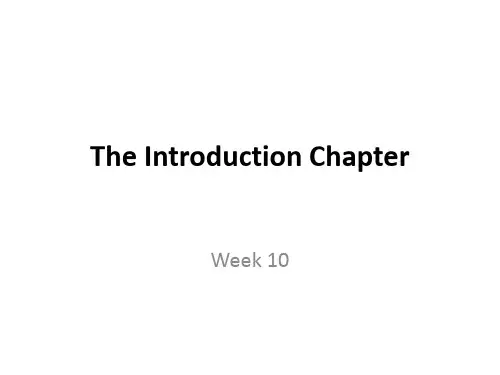
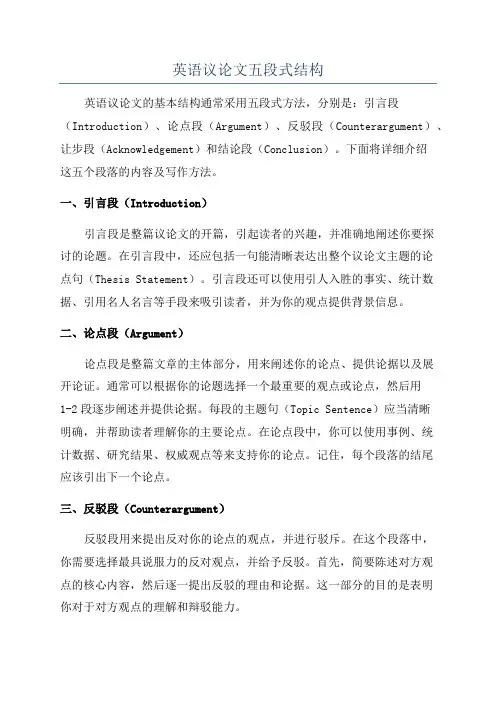
英语议论文五段式结构英语议论文的基本结构通常采用五段式方法,分别是:引言段(Introduction)、论点段(Argument)、反驳段(Counterargument)、让步段(Acknowledgement)和结论段(Conclusion)。
下面将详细介绍这五个段落的内容及写作方法。
一、引言段(Introduction)引言段是整篇议论文的开篇,引起读者的兴趣,并准确地阐述你要探讨的论题。
在引言段中,还应包括一句能清晰表达出整个议论文主题的论点句(Thesis Statement)。
引言段还可以使用引人入胜的事实、统计数据、引用名人名言等手段来吸引读者,并为你的观点提供背景信息。
二、论点段(Argument)论点段是整篇文章的主体部分,用来阐述你的论点、提供论据以及展开论证。
通常可以根据你的论题选择一个最重要的观点或论点,然后用1-2段逐步阐述并提供论据。
每段的主题句(Topic Sentence)应当清晰明确,并帮助读者理解你的主要论点。
在论点段中,你可以使用事例、统计数据、研究结果、权威观点等来支持你的论点。
记住,每个段落的结尾应该引出下一个论点。
三、反驳段(Counterargument)反驳段用来提出反对你的论点的观点,并进行驳斥。
在这个段落中,你需要选择最具说服力的反对观点,并给予反驳。
首先,简要陈述对方观点的核心内容,然后逐一提出反驳的理由和论据。
这一部分的目的是表明你对于对方观点的理解和辩驳能力。
四、让步段(Acknowledgement)让步段用来表明你主张的论点并不是绝对正确,存在一定的局限性。
在这个段落中,你可以通过承认一些相对的真实性或合理性来增加你论点的可信度。
与此同时,你仍然要强调自己的观点正确性的主要方面。
这部分的目的是表明你能够考虑到问题的多方面角度,并加强你的论证力度。
五、结论段(Conclusion)结论段是整篇文章的总结和结束。
在结论段中,你需要重新强调你的主要观点和论点,并总结你的关键论证。
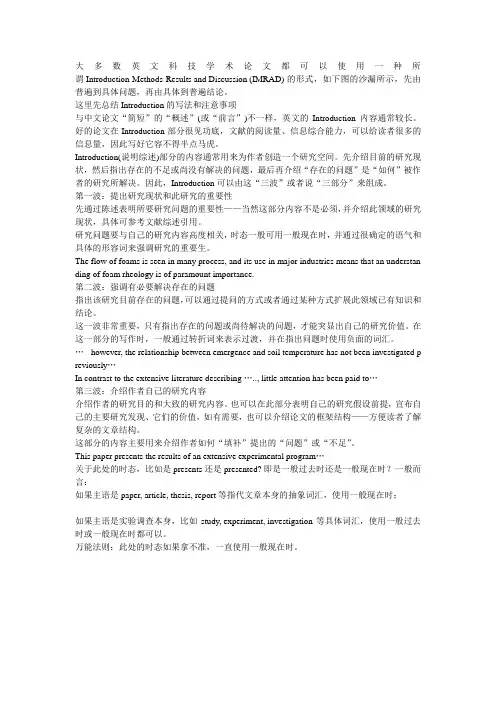
大多数英文科技学术论文都可以使用一种所谓 Introduction-Methods-Results and Discussion (IMRAD) 的形式,如下图的沙漏所示,先由普遍到具体问题,再由具体到普遍结论。
这里先总结Introduction的写法和注意事项与中文论文“简短”的“概述”(或“前言”)不一样,英文的Introduction内容通常较长。
好的论文在Introduction部分很见功底,文献的阅读量、信息综合能力,可以给读者很多的信息量,因此写好它容不得半点马虎。
Introduction(说明综述)部分的内容通常用来为作者创造一个研究空间。
先介绍目前的研究现状,然后指出存在的不足或尚没有解决的问题,最后再介绍“存在的问题”是“如何”被作者的研究所解决。
因此,Introduction可以由这“三波”或者说“三部分”来组成。
第一波:提出研究现状和此研究的重要性先通过陈述表明所要研究问题的重要性——当然这部分内容不是必须,并介绍此领域的研究现状,具体可参考文献综述引用。
研究问题要与自己的研究内容高度相关,时态一般可用一般现在时,并通过很确定的语气和具体的形容词来强调研究的重要生。
The flow of foams is seen in many process, and its use in major industries means that an understan ding of foam rheology is of paramount importance.第二波:强调有必要解决存在的问题指出该研究目前存在的问题,可以通过提问的方式或者通过某种方式扩展此领域已有知识和结论。
这一波非常重要,只有指出存在的问题或尚待解决的问题,才能突显出自己的研究价值。
在这一部分的写作时,一般通过转折词来表示过渡,并在指出问题时使用负面的词汇。
… however, the relationship between emergence and soil temperature has not been investigated p reviously…In contrast to the extensive literature describing ….., little attention has been paid to…第三波:介绍作者自己的研究内容介绍作者的研究目的和大致的研究内容。
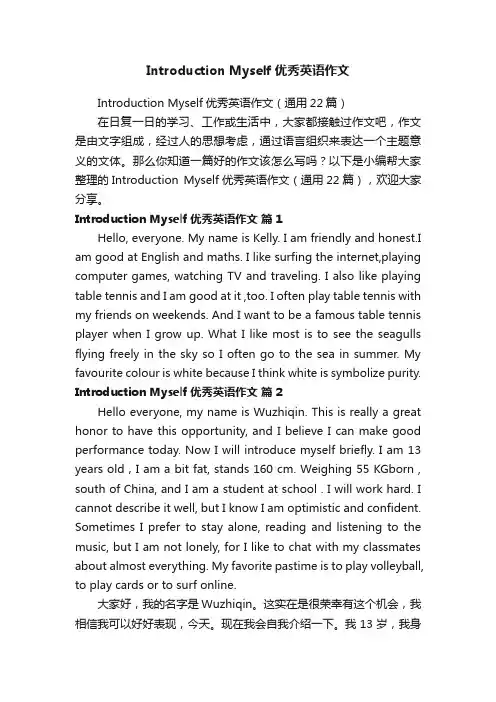
Introduction Myself优秀英语作文Introduction Myself优秀英语作文(通用22篇)在日复一日的学习、工作或生活中,大家都接触过作文吧,作文是由文字组成,经过人的思想考虑,通过语言组织来表达一个主题意义的文体。
那么你知道一篇好的作文该怎么写吗?以下是小编帮大家整理的Introduction Myself优秀英语作文(通用22篇),欢迎大家分享。
Introduction Myself优秀英语作文篇1Hello, everyone. My name is Kelly. I am friendly and honest.I am good at English and maths. I like surfing the internet,playing computer games, watching TV and traveling. I also like playing table tennis and I am good at it ,too. I often play table tennis with my friends on weekends. And I want to be a famous table tennis player when I grow up. What I like most is to see the seagulls flying freely in the sky so I often go to the sea in summer. My favourite colour is white because I think white is symbolize purity. Introduction Myself优秀英语作文篇2Hello everyone, my name is Wuzhiqin. This is really a great honor to have this opportunity, and I believe I can make good performance today. Now I will introduce myself briefly. I am 13 years old,I am a bit fat, stands 160 cm. Weighing 55 KGborn , south of China, and I am a student at school . I will work hard. I cannot describe it well, but I know I am optimistic and confident. Sometimes I prefer to stay alone, reading and listening to the music, but I am not lonely, for I like to chat with my classmates about almost everything. My favorite pastime is to play volleyball, to play cards or to surf online.大家好,我的名字是Wuzhiqin。

英语专四作文introduction As a language learner, I believe that mastering English
is essential for both personal and professional development. In today's globalized world, English has become a lingua franca, and proficiency in this language can open up a
world of opportunities. Whether it's for traveling,
studying abroad, or pursuing a career in an international company, being able to communicate effectively in English
is a valuable skill that can greatly enhance one's life.
作为一个语言学习者,我相信掌握英语对个人和职业发展至关重要。
在当今全球化的世界中,英语已成为一种通用语言,精通这种
语言可以打开机会的大门。
无论是为了旅行、出国留学,还是追求
在国际公司工作,能够有效地用英语交流是一项极具价值的技能,
可以极大地改善一个人的生活。
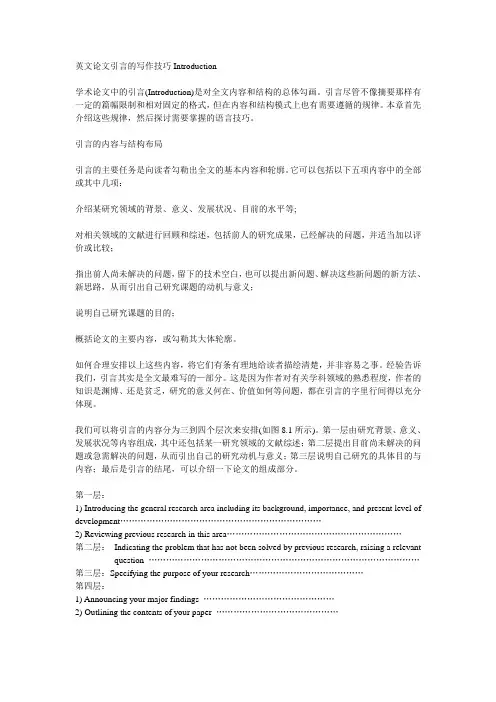
英文论文引言的写作技巧Introduction学术论文中的引言(Introduction)是对全文内容和结构的总体勾画。
引言尽管不像摘要那样有一定的篇幅限制和相对固定的格式,但在内容和结构模式上也有需要遵循的规律。
本章首先介绍这些规律,然后探讨需要掌握的语言技巧。
引言的内容与结构布局引言的主要任务是向读者勾勒出全文的基本内容和轮廓。
它可以包括以下五项内容中的全部或其中几项:介绍某研究领域的背景、意义、发展状况、目前的水平等;对相关领域的文献进行回顾和综述,包括前人的研究成果,已经解决的问题,并适当加以评价或比较;指出前人尚未解决的问题,留下的技术空白,也可以提出新问题、解决这些新问题的新方法、新思路,从而引出自己研究课题的动机与意义;说明自己研究课题的目的;概括论文的主要内容,或勾勒其大体轮廓。
如何合理安排以上这些内容,将它们有条有理地给读者描绘清楚,并非容易之事。
经验告诉我们,引言其实是全文最难写的—部分。
这是因为作者对有关学科领域的熟悉程度,作者的知识是渊博、还是贫乏,研究的意义何在、价值如何等问题,都在引言的字里行间得以充分体现。
我们可以将引言的内容分为三到四个层次来安排(如图8.1所示)。
第一层由研究背景、意义、发展状况等内容组成,其中还包括某一研究领域的文献综述;第二层提出目前尚未解决的问题或急需解决的问题,从而引出自己的研究动机与意义;第三层说明自己研究的具体目的与内容;最后是引言的结尾,可以介绍一下论文的组成部分。
第一层:1) Introducing the general research area including its background, importance, and present level of development……………………………………………………………2) Reviewing previous research in this area……………………………………………………第二层:Indicating the problem that has not been solved by previous research, raising a relevant question …………………………………………………………………………………第三层:Specifying the purpose of your research…………………………………第四层:1) Announcing your major findings ………………………………………2) Outlining the contents of your paper ……………………………………图8.1 引言的结构布局之一值得注意的是,引言中各个层次所占的篇幅可以有很大差别。
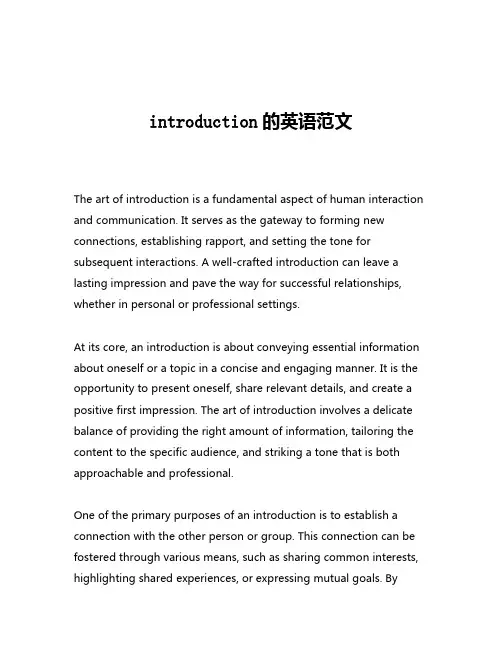
introduction的英语范文The art of introduction is a fundamental aspect of human interaction and communication. It serves as the gateway to forming new connections, establishing rapport, and setting the tone for subsequent interactions. A well-crafted introduction can leave a lasting impression and pave the way for successful relationships, whether in personal or professional settings.At its core, an introduction is about conveying essential information about oneself or a topic in a concise and engaging manner. It is the opportunity to present oneself, share relevant details, and create a positive first impression. The art of introduction involves a delicate balance of providing the right amount of information, tailoring the content to the specific audience, and striking a tone that is both approachable and professional.One of the primary purposes of an introduction is to establish a connection with the other person or group. This connection can be fostered through various means, such as sharing common interests, highlighting shared experiences, or expressing mutual goals. Byfinding common ground, the introduction can create a sense of familiarity and trust, making the subsequent interaction more productive and meaningful.Moreover, a well-crafted introduction can set the stage for a successful dialogue. It allows the individual to position themselves within the context of the conversation, providing the necessary background information and setting the expectations for the exchange. This can be particularly important in formal or professional settings, where the introduction serves as a gateway to more substantive discussions and collaborative efforts.In addition to fostering connections and setting the stage for productive interactions, a strong introduction can also convey confidence and competence. The way one presents themselves, the clarity of their communication, and the depth of the information shared can all contribute to the perception of the individual's capabilities and credibility. A confident and well-prepared introduction can help establish the individual as a valuable contributor, opening doors to new opportunities and enhancing their professional reputation.Furthermore, the art of introduction extends beyond the initial encounter. It is an ongoing process that continues throughout the course of a relationship or interaction. As situations and contextschange, the individual must be able to adapt their introduction to suit the evolving needs and expectations of their audience. This adaptability demonstrates versatility and the ability to navigate different social and professional environments effectively.In the digital age, the importance of introduction has become even more pronounced. Online interactions, such as virtual meetings, job applications, and social media profiles, require individuals to craft introductions that are succinct, attention-grabbing, and representative of their true selves. The ability to effectively introduce oneself in these digital spaces can significantly impact the success of personal and professional pursuits.Overall, the art of introduction is a critical skill that encompasses a multitude of elements, from establishing connections and setting the tone to conveying confidence and adaptability. Mastering this art can open doors, facilitate meaningful dialogues, and pave the way for lasting, productive relationships. Whether in personal or professional settings, a well-crafted introduction can serve as the foundation for a successful and fulfilling interaction.。

introduce英语作文英文回答:Introduction: A Vital Component of Academic and Professional Writing.The introduction serves as the opening paragraph of any academic or professional writing. It plays a crucial rolein capturing the reader's attention, establishing the context, and providing an overview of the main argument or thesis. The introduction should be both concise and engaging, providing a clear roadmap for the rest of the document.Key Functions of Introduction:Grab attention: The introduction must hook the reader and make them interested in reading further. This can be achieved through a compelling anecdote, a provocative question, or a surprising statistic.Establish context: The introduction should provide background information on the topic and explain why it is significant. This helps readers understand the relevance of the document and its purpose.State thesis statement: The thesis statement is the central argument or claim that the document will support. The introduction should clearly state the thesis, providing a clear focus for the writing.Provide roadmap: The introduction should outline the main points or arguments that will be discussed in the rest of the document. This helps readers follow the logical flow of the writing and anticipate what is to come.Effective Introduction Writing:Be concise: The introduction should be brief and to the point, typically not exceeding 5-10% of the total length of the document.Use strong language: Employ vivid and precise language to make the writing engaging and memorable.Maintain clarity: The introduction should be easy to understand, avoiding jargon or technical terms that may confuse readers.Connect to reader: The introduction should connect with the reader on a personal level or relate to their interests to foster a sense of relevance.中文回答:引言,学术和职业写作中的重要组成部分。

怎样写好英文论文的Introduction部分?在论文写作过程中,很多同学搞不清abstract和introduction的区别,认为这两个部分都是一样的,由于概念的模糊导致introduction的写作存在问题。
那么什么是introduction,又应该怎么写这一部分呢?摘要我们都知道主要是对文章内容从选题背景,主要内容和研究问题三个部分来概述。
而Introduction部分是要求内容在对应的选题上更加精确,即通过承接摘要部分提出的内容来展开话题,从比较宏观的学术背景逐渐过渡到本文的研究课题来说服目标读者。
Introduction部分需要明确呈现的三个部分:一是background;二是research gap;三是study purpose。
总的来说,就是从what is known到what is unknown最后推出自己的研究问题。
所以Introduction一开始要陈述的是自己研究课题领域的大背景和重要性,第一部分的主要目的是向读者展示自己选择的研究方向前人有过那些经典的理论和实验,证明你对这个领域已经有全面客观的了解。
这样才能向第二部分进行。
第二部分即找到课题领域的研究空白。
所谓空白,包括尚未设涉及的问题和前人没有研究透彻或者随着该领域发展一些需要理论或实验需要进行进一步修正。
这些都可以作为你了解到的研究空白,同时为你接下来的选题陈述奠定基础。
接下来就是要基于前两个部分的陈述点出本文的研究课题、研究意义和采用的研究方法。
写Introduction有几个需要注意的问题:首先在字数上不要过多,尤其在概述背景的部分,不要堆砌罗列文献,要选择与自己选题密切相关的著作或著名理论来陈述。
其次要时刻记得Introduction的目的是要让读者通过对这一部分的阅读对你的研究产生兴趣,即吸引读者。
Introduction属于论文中最难写的部分之一,这一部分的成败直接影响到你整篇论文的质量。
所以要在初稿完成后反复修改,不要过多赘述也不要一带而过。
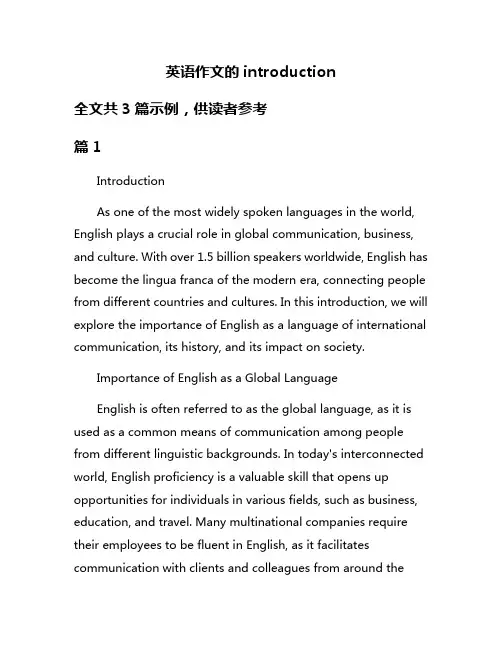
英语作文的introduction全文共3篇示例,供读者参考篇1IntroductionAs one of the most widely spoken languages in the world, English plays a crucial role in global communication, business, and culture. With over 1.5 billion speakers worldwide, English has become the lingua franca of the modern era, connecting people from different countries and cultures. In this introduction, we will explore the importance of English as a language of international communication, its history, and its impact on society.Importance of English as a Global LanguageEnglish is often referred to as the global language, as it is used as a common means of communication among people from different linguistic backgrounds. In today's interconnected world, English proficiency is a valuable skill that opens up opportunities for individuals in various fields, such as business, education, and travel. Many multinational companies require their employees to be fluent in English, as it facilitates communication with clients and colleagues from around theworld. Moreover, English is the primary language of instruction in many universities, making it essential for students who wish to pursue higher education abroad.History of the English LanguageThe English language has a rich and diverse history, shaped by various influences over the centuries. Originating from the Germanic tribes that invaded Britain in the 5th century, Old English was the language spoken by the Anglo-Saxons. The Norman Conquest of 1066 brought French elements into the language, leading to the Middle English period. During the Renaissance, many Latin and Greek words were incorporated into English, transforming it into the Modern English we know today. The spread of the British Empire in the 18th and 19th centuries further promoted the global use of English, solidifying its status as an international language.Impact of English on SocietyThe widespread use of English has had a profound impact on society, shaping the way we communicate, learn, and interact with one another. English has become the language of the internet, with the majority of online content available in English. This has made information more accessible to a global audience, breaking down barriers and fostering cross-culturalunderstanding. English also plays a key role in the entertainment industry, with many movies, TV shows, and music produced in English reaching a worldwide audience.ConclusionIn conclusion, English is a language that transcends borders and connects people from different corners of the globe. Its significance as a tool for communication, education, and business cannot be overstated. As we continue to navigate an increasingly interconnected world, proficiency in English will be essential for individuals seeking to thrive in a globalized society.篇2Title: Introduction to English CompositionIntroduction:English composition is an essential skill that every student should strive to master. Whether you are writing an essay, a research paper, a report, or any other type of written work, having a solid foundation in English composition will help you communicate your ideas effectively and clearly. In this introductory essay, we will discuss the importance of English composition, the key components of a well-written piece, and tips to improve your writing skills.Importance of English Composition:English composition is the art of expressing thoughts, ideas, and emotions through written words. It allows individuals to communicate their thoughts and experiences with others, creating a connection between writer and reader. A well-written composition can persuade, inform, entertain, or provoke thought, making it a powerful tool for communication.In academic settings, English composition plays a crucial role in developing critical thinking skills, analytical abilities, and communication proficiency. Students who excel in English composition are better equipped to analyze complex ideas, synthesize information, and present their arguments effectively. This skill is essential for success in higher education, as well as in the professional world.Key Components of a Well-Written Composition:A well-written composition should have a clear structure, coherent organization, and strong supporting evidence. The key components of a well-written piece include:1. Introduction: The introduction should grab the reader's attention, provide context for the topic, and present the thesis statement.2. Body: The body of the composition should present the main points of the argument, supported by evidence and examples. Each paragraph should relate to the overall thesis and flow logically from one to the next.3. Conclusion: The conclusion should summarize the main points, restate the thesis, and leave a lasting impression on the reader.Tips to Improve Your Writing Skills:To improve your English composition skills, consider the following tips:1. Read widely: Reading books, articles, and essays can expose you to different writing styles, vocabulary, and ideas.2. Practice writing: The more you write, the better you will become. Set aside time each day to practice writing and experiment with different techniques.3. Seek feedback: Ask for feedback from peers, teachers, or writing tutors to help you identify areas for improvement.4. Edit and revise: Always edit and revise your work to check for grammar, spelling, and punctuation errors, as well as clarity and coherence.5. Study grammar and vocabulary: Understanding grammar rules and expanding your vocabulary can enhance the quality of your writing.Conclusion:English composition is a valuable skill that can benefit you in academic, professional, and personal endeavors. By mastering the key components of a well-written composition and following the tips provided, you can improve your writing skills and become a more effective communicator. Remember that practice makes perfect, so don't be afraid to challenge yourself and strive for excellence in English composition.篇3IntroductionEnglish writing is a key skill that is essential for academic, professional, and personal success. In today's globalized world, the importance of being able to effectively communicate in written English cannot be overstated. Whether you are writing an essay, a report, a business proposal, or even just a simple email, strong writing skills are crucial for conveying your ideas clearly and persuasively.In this essay, we will explore the importance of English writing, the key components of a well-written piece of writing, and some strategies for improving your English writing skills. We will also discuss the different types of English writing, such as narrative, descriptive, expository, and persuasive writing, and provide tips for each.English writing is not just about following grammar rules and using fancy vocabulary. It is about structuring your ideas in a logical and coherent way, using appropriate language for your audience, and engaging your readers through interesting and relevant content. Good writing is also about editing and revising your work to ensure that it is clear, concise, and error-free.By honing your English writing skills, you will be able to express yourself effectively in a variety of contexts and achieve your goals more easily. Whether you are a student looking to excel in school, a professional seeking to advance in your career, or simply someone who wants to communicate more clearly and persuasively, improving your English writing skills will open up a world of opportunities for you.In the following sections, we will delve deeper into the art of English writing, exploring the key principles, techniques, and strategies that will help you become a more confident andproficient writer. Let's embark on this journey together and unlock the power of English writing.。
怎么写论文的Introduction部分
写引言,首先需要确定你做了什么和你发现了什么,所以写引言的最佳时间是在写完整篇文章之后,或者至少起草了报告的各个部分之后。
一般来说文章的结构通常是按照如Fig.1. 来完成。
Fig. 1. The shape of a research article or thesis.
从图表的形状中可以注意到的一点是,论文写作中思路是逐渐向中央部分变窄,之后变宽的。
这表明信息在introduction和
Discussion/Conclusion中的排序方式:在introduction中,开始时相当笼统,逐渐缩小你的研究焦点,然后展开你的研究方法和实验结果。
而在讨论/结论中则相反,你需要将你的观点再重新展宽回到引言最开始的层次中讨论。
做一个不太恰当的比喻,如果把写论文比作是讲一个故事的话,首先故事开始前,需要一个开场白暖一下场,这部分内容是用来让你的读者,可能是不了解你的讲故事风格,或者赶时间只是来随便听听的人能够进入到故事的氛围中来。
暖场结束之后,需要逐步引导读者深入探索,所以一般在introduction的结尾,需要一段话将故事的前期铺垫衔接上故事的主体,也就是方法和结果部分。
在这里,你将给读者展现你的逻辑思考和实验设计,并介绍实验结果,利用实验数据得出结论。
主体介绍完成之后就是讨论和结论部分,在这里需要给读者留下想象空间,或者将故事的主题突显出来。
同样的,在这两者之间加入一段衔接的话是必要的。
下面展示一段引言的范例:
Fig. 2. An e某ample introduction paragraph.。
introduction英语作文introduction英语作文无论是在学校还是在社会中,大家对作文都不陌生吧,通过作文可以把我们那些零零散散的思想,聚集在一块。
那么一般作文是怎么写的'呢?下面是小编收集整理的introduction英语作文,欢迎大家借鉴与参考,希望对大家有所帮助。
introduction英语作文1Hello, I am Cao Wanqian. I am a smart girl.I am 12 years old.I have short and black hair and small eyes.Purple is my favourite colour. Kangaroo is my favourite animal.I have a good friend. It’s name’s Zhao Xhuanru, It’s funny.I like she.introduction英语作文2Hello!My name is Ding Jinyan.My English name is Tina.I am a chinese girl.I’m 12 years old.In my family,there are four people.My mother,father,bother ang me.I like watching TV,playing computer games,reading books and playing the guitar.I’m a clever girl.My dream is to be a star.I like English,Chinese,Music and History.My favourite subject is English.Because learning English is very happy and exciting.Do you want to be my friend?。
英文作文introduction英文,As an introduction, I would like to share alittle bit about myself. My name is Lily, and I am a 25-year-old college student from China. I am majoring in international business, and I have always been passionate about learning new languages and experiencing different cultures.中文,作为一个介绍,我想跟大家分享一下关于我自己的一些事情。
我的名字叫莉莉,我是一名来自中国的25岁大学生。
我主修国际贸易,我一直热衷于学习新的语言和体验不同的文化。
英文,I have been learning English since I was in elementary school, and I have also studied Japanese and Spanish. I believe that being multilingual has opened up many opportunities for me, both in terms of my education and my personal growth.中文,我从小学开始学习英语,还学过日语和西班牙语。
我相信多语言的能力为我打开了很多机会,无论是在教育上还是在个人成长上。
英文,In addition to my passion for languages, I also love to travel. I have been fortunate enough to visit several countries, including the United States, Japan, and Spain. These experiences have allowed me to broaden my horizons and gain a deeper understanding of different customs and traditions.中文,除了对语言的热爱,我还热爱旅行。
IntroductionChina is an oriented country with five-thousand-year-old history, attracting tourists from all over the world. Covering an area of 9.6milliom square kilometers, China has abundant tourism resources, boasting of spectacular natural sceneries and cultural relics. China’s tourism industry has undergone an unprecedented growth. According to World Tourism Organization (WTO) forecast, China is set to become the world’s largest tourism destination and the fourth major source of tourists b y 2020.Therefore, tourism has become a significant industry in the national economy.After the opening-up and reform policy, China has received millions of foreign visitors who are attracted by China’s natural landscape and human culture. To help foreign tourists know China well and to make a good impression on them, Tour Commentaries, as a forcible medium, plays an irreplaceable role while the translation of them is of equal importance.Tour is a linguistically communicative activity between the translator and tourists and all kinds of linguistic communication have an inherent feature that is cooperation. The most famous and systematic notion of what linguistic cooperation mean is Grice’s description of some effects of communicative activities (Hickey, 2001). Many translators and scholars have contributed to the theory applying to the translation. Hicky(2001)said that the Gricean account is developed primarily with spoken conversation in mind, however it does written texts, he pointed out that it is feasible to argue that the fact of translation severs this connection, or the very translation text severs the connection between the writer’s intentions and the target-language readers’ recognition of them.And domestically, Duan Haiyan(2007)and Zhang Jin(2008)pays much attention to the features of language in English introduction in her paper without clear and classified translation methods. Other scholars discuss translation skills of Tour Commentaries from different angles, Chen Gang (2002) points out that the translator should develop cross-cultural consciousness in five aspects and suggests some translation strategies to solve the problems in TC. Zeng Dan (2006) discusses thetranslation strategies in terms of the functional theory and has a further exploration on the translation of dynasty, historical figure culture proper noun. Xiong Linlin(2007) gives an in-depth discourse analysis at the macro-level of Tour Commentaries on the basis of Nord’ discourse model on relevance theory.The contents of TC are relevant to the local characters, Zhangjiajie is no exception. Located in the northwest part of Hunan Province, Zhangjiajie is a place with pleasant scenery of typical Karst formation and multiple ethnic minorities including Tujia ethnic minority and Miao ethnic minority. Many data about scenic spots in Zhangjiajie have been collected for detailed analysis in this study,which is to improve the quality of tourism translation and to attract more foreigners to visit China. The author collected brochures, books and notices and websites about the scenic spots in Zhangjiajie which will be cited for the analysis in the thesis.A comparative analytical case-study method will be adopted, and this contrastive analysis is conducted from lexical and syntactic features to discourse norm and culture conventions.Source texts and target texts of the tourist commentaries are paired up for analysis.Examples are employed to illustrate the applied translating methods.The purpose is to give a tentative reconstruction of the translation process based on CP.After the collection of TC, it can be found that the quantity of TC’s translation unconsciously is not satisfied. There are many problems in the TC of scenic spots in Zhangjiajie: not united proper nouns, ambiguous expressions, unnecessary prolixity, unbelievable legends, irrelevant interpretations, and exaggerations etc. In this study, four maxims will be applied to analyze the problems during the translation of the source texts; finally some suitable translation strategies are put forward based on Grice’s CP and its four maxims with practical examples to improve the quality of TC translation of Zhangjiajie.。
essay introduction模板in thispaper以下是一个论文引言(essay introduction)的模板,你可以根据需要进行调整和修改,以确保满足字数要求。
**标题:[论文题目]**In this paper, we aim to explore the topic of [具体研究主题] and its significance in [相关领域或背景]. This topic has attracted considerable attention in recent years, due to its profound impact on [阐述研究主题的重要性和影响]. Our primary objective is to provide a comprehensive examination of [研究目标或问题], shedding light on its various aspects and complexities.To achieve this goal, we have employed a multi-faceted approach, utilizing both qualitative and quantitative methodologies. By conducting extensive literature reviews, case studies, experiments, or surveys, we have gathered a wealth of data and insights to inform our analysis. This diverse range of methods allows us to approach the subject from different perspectives, enhancing the credibility and validity of our findings.The paper is structured as follows: Firstly, we will delve into the theoretical foundations of [研究主题], exploring relevant concepts, theories, and previous research in the field. This section will provide a solid framework for understanding the subsequent discussions. Subsequently, we will present the methodology employed in our research, detailing the data collection techniques and analytical procedures employed. Following this, the results of our investigation will be presented, accompanied by in-depth discussions and interpretations. Finally, we will summarize the key findings of the study, discuss their implications, and propose potential areas for future research.Throughout this paper, we strive to contribute to the existing body of knowledge on [研究主题] by offering novel insights, theoretical contributions, or practicalimplications. Our hope is that this work will not only enhance understanding of the subject matter but also inspire further research and discussions among scholars and practitioners in the field.。
英文论文引言的写作技巧Introduction
学术论文中的引言(Introduction)是对全文内容和结构的总体勾画。
引言尽管不像摘要那样有一定的篇幅限制和相对固定的格式,但在内容和结构模式上也有需要遵循的规律。
本章首先介绍这些规律,然后探讨需要掌握的语言技巧。
引言的内容与结构布局
引言的主要任务是向读者勾勒出全文的基本内容和轮廓。
它可以包括以下五项内容中的全部或其中几项:
介绍某研究领域的背景、意义、发展状况、目前的水平等;
对相关领域的文献进行回顾和综述,包括前人的研究成果,已经解决的问题,并适当加以评价或比较;
指出前人尚未解决的问题,留下的技术空白,也可以提出新问题、解决这些新问题的新方法、新思路,从而引出自己研究课题的动机与意义;
说明自己研究课题的目的;
概括论文的主要内容,或勾勒其大体轮廓。
如何合理安排以上这些内容,将它们有条有理地给读者描绘清楚,并非容易之事。
经验告诉我们,引言其实是全文最难写的—部分。
这是因为作者对有关学科领域的熟悉程度,作者的知识是渊博、还是贫乏,研究的意义何在、价值如何等问题,都在引言的字里行间得以充分体现。
我们可以将引言的内容分为三到四个层次来安排(如图8.1所示)。
第一层由研究背景、意义、发展状况等内容组成,其中还包括某一研究领域的文献综述;第二层提出目前尚未解决的问题或急需解决的问题,从而引出自己的研究动机与意义;第三层说明自己研究的具体目的与内容;最后是引言的结尾,可以介绍一下论文的组成部分。
第一层:
1) Introducing the general research area including its background, importance, and present level of development……………………………………………………………
2) Reviewing previous research in this area……………………………………………………
第二层:Indicating the problem that has not been solved by previous research, raising a relevant question …………………………………………………………………………………第三层:Specifying the purpose of your research…………………………………
第四层:
1) Announcing your major findings ………………………………………
2) Outlining the contents of your paper ……………………………………
图8.1 引言的结构布局之一
值得注意的是,引言中各个层次所占的篇幅可以有很大差别。
这一点与摘要大不一样,摘要中的目的、方法、结果、结论四项内容各自所占的篇幅大体比例一样(见7.2节)。
而在引言中,第一个层次往往占去大部分篇幅。
对研究背景和目前的研究状况进行较为详细的介绍。
研究目的可能会比较简短。
引言与摘要还有一点不同的是,摘要中必须把主要研究结果列出,而在引言中(如果摘要与正文一同登出)结果则可以省略不写,这是因为正文中专门有一节写结果(results),不必在引言中重复。